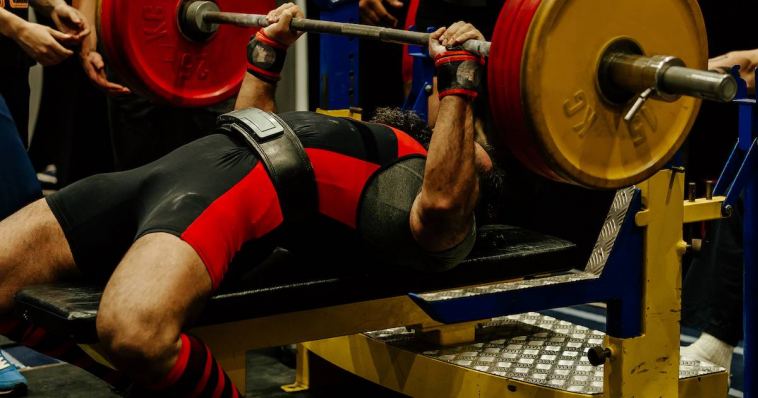- Like
- SHARE
- Digg
- Del
- Tumblr
- VKontakte
- Flattr
- Buffer
- Love This
- Save
- Odnoklassniki
- Meneame
- Blogger
- Amazon
- Yahoo Mail
- Gmail
- AOL
- Newsvine
- HackerNews
- Evernote
- MySpace
- Mail.ru
- Viadeo
- Line
- Comments
- Yummly
- SMS
- Viber
- Telegram
- JOIN
- Skype
- Facebook Messenger
- Kakao
- LiveJournal
- Yammer
- Edgar
- Fintel
- Mix
- Instapaper
- Copy Link
Have you ever said any of the following about your bench press?
“I almost had it, I just mis-grooved the lift.”
“I always get pinned at the bottom of my bench.”
“I can touch and go this weight, but when I pause my bench, I’m so much weaker.”
“My overhead press and other bench accessories all got stronger but my bench stayed the same.”
These are comments I frequently hear from people who are struggling to increase their bench press.
The good news is they’re easily fixed by identifying the underlying problem and implementing effective solutions to address them.
Typically when people fail, their bench presses a few inches off their chest because of one or more of these reasons.
- Weak pecs relatively to their shoulders and triceps.
- Inability to rapidly absorb and reverse the direction of the load.
- Poor technique.
When the bar is touching your chest, your pecs are stretched and in an advantageous position to generate force and reverse the load.
However, at that same bottom position, your shoulders and triceps are at a disadvantaged point of leverage.
Their primary contribution occurs closer to the mid-range and upward.
That’s generally the point where we see the elbows flair to transfer loading demand from the pecs to the shoulders and triceps in an attempt to complete the lift.
I am going to provide an overview explanation here but if you need to work on your own specific goals or have other issues just contact me at Stacked Strength.
Weak Pectorals
When a lifter mis-grooves a lift right off the chest, it’s often indicative of weak pecs.
Since the pecs aren’t capable of generating enough force to press the weight up, the elbows flare excessively to shift loading demands onto the triceps and shoulders.
However, as mentioned earlier, at the bottom of the rep, the triceps and shoulders are at a disadvantaged mechanical position to press the weight.
So weak pecs are typically the culprit when an athlete fails a rep a few inches off the chest.
However, this often goes hand in hand with an inability to effectively absorb the load and maximize the stretch-shortening cycle. As the athlete lowers the bar, if eccentric and isometric strength is insufficient, they will not absorb the load leading to a decrease in elastic energy.
This energy, if not lost, would be used to reverse the weight from the chest rapidly.
Poor Technique
Another major contributing factor to failing is poor technique.
But there are several articles and instructional videos on how to optimize bench press technique based on your leverages and experience.
So, the technique won’t be the primary focus of this article since the assumption is that the technique is not the limiting factor.
Here I’m going to teach you a simple strategy that tackles both of these major issues so you can start hitting some new PR’s.
Who Benefits?
But first, let’s talk about who this is for. As mentioned previously, if you fail at the chest, or if you often mis-groove lifts or struggle with paused reps, and assuming your technique is decent, you likely have weak pecs.
Also, you likely lack the specific eccentric and isometric strength to both absorb and reverse the weight.
If this sounds like you, then this strategy can help. The individuals who primarily have these issues are beginners and intermediate lifters.
Advanced athletes are a bit more complex, which can make the solutions equally complex. But I digress.
The Solution
Below is a video demonstration of an effective exercise to correct the aforementioned issues.
The strategy I discuss can be implemented with various pressing exercises with great success and isn’t limited to the demonstration below.
An additional benefit to using tempo while simultaneously removing your mechanical advantages is that it places greater demand on the targeted muscles and connective tissue without generating the same fatigue.
This is because, although the exercise feels challenging, the absolute load is lighter than if you were to do a full powerlifting setup and select a load of the same relative intensity.
For example, with a proper powerlifting setup, you might do a set of 8 at 100 lbs, but if you do a set of 8 at 70 lbs utilizing tempo, it may not feel easier.
Same relative intensity, but less absolute load.
This reduction in absolute load reduces the amount of stress being placed on your body. This allows you to have more productive training sessions within a microcycle without exceeding your ability to recover.


